From pioneering social enterprises to rewilding initiatives, read my round-up of the world’s top responsible tourism destinations and get inspired for your next trip.
Travel is both a blessing and a curse. It fuels local economies and opens our minds, but it can also destroy ecosystems and exploit vulnerable communities. To be responsible and sustainable, travel needs to have a balance between enjoyment and responsibility.
Destinations across the world have started to recognise the benefits of responsible tourism for creating a positive impact on the environment, local communities and economies.
These 31 eco-friendly destinations use tourism to put nature and communities first. They prove that you can take enjoyment from the natural world whilst protecting it too.
1. New Zealand

New Zealand is one of the best responsible tourism destinations in the world. Ecotourism is the fastest-growing sector in the country’s tourism industry and you’re spoilt for choice of things to do.
There are over 10,000 protected areas, including reserves and 13 national parks. Visitors can enjoy plenty of educational activities, work on farms, take tours and learn about Maori culture.
New Zealand is also one of my favourite destinations for solo travellers.
2. Costa Rica

Costa Rica is home to 6% of the world’s biodiversity so it comes as no surprise that the country is a world leader in conservation.
A prime location for ecotourists, more than 11% of Costa Rica is protected in national parks and reserves. Stunning ecolodges are also common throughout the country.
Thrilling highlights include spotting the local wildlife, hiking, volcano hopping, chocolate tours and ziplining through the rainforests.
3. Republic of Palau

Palau is making waves on the sustainable travel scene.
A new initiative launched by the Palau Bureau of Tourism aims to mitigate the tourism sector’s carbon footprint and turn the country into the world’s first carbon-neutral destination.
This small island nation also has one of the world’s largest marine sanctuaries and tour operators and tourists are banned from using single-use plastic, non-reef-safe sunscreen and styrofoam.
For tips on how to cut plastic out of your packing list, check out my eco-friendly packing list.
Perhaps most significant of all, every visitor must sign the Palau Pledge on arrival to protect the country’s ecosystem.
4. Bhutan
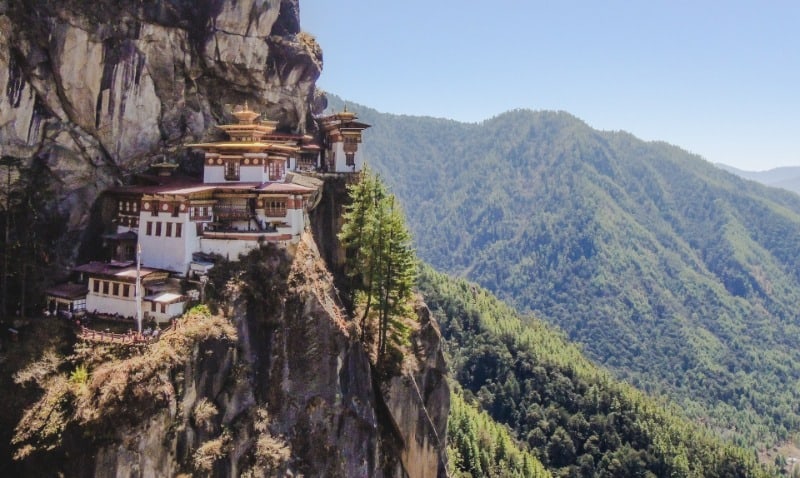
This small Buddhist kingdom located in the Himalayas has built its tourism industry with sustainability in mind.
All visitors must use a guide and pay US$65 per person for the number of days they’re planning to stay and the money is used for social development to sustain the country.
The preservation of the environment and culture is a key part of Bhutan’s ethos and it’s understandable when 72% of its territory is covered in forests.
Bhutan is also the world’s only carbon-negative country, producing fewer carbon emissions than its forests absorb. Goals!
Read More: Forest Bathing Therapy: What It Is and How to Do It
5. The Maldives
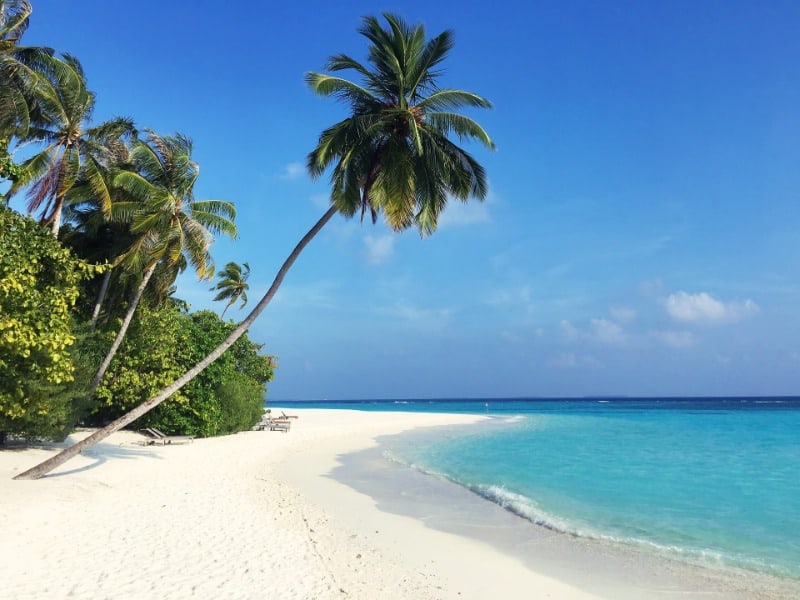
The Maldives is a top luxury holiday destination, however, this archipelago of islands and atolls has stepped up its game to ensure that its fragile ecosystem is protected.
To eliminate the scourge of plastic waste, some resorts have set up their own recycling and glass water bottling plants.
Fishing is strictly regulated to manage the marine life and visitors must pay a US$6 Green Tax per person per day. If you love the ocean then the Maldives is the place to be.
Highlights include sailing trips and diving alongside turtles and whale sharks. You can also absolutely visit the Maldives as a solo traveller. It’s not just for honeymooners!
6. Norway

It’s no secret that Norway is one of the world’s top sustainable travel destinations. Going green for the planet is heavily imbued in Norwegian culture, not just its tourism sector.
The country has one of the most efficient recycling systems in the world and you’re rewarded for returning bottles and aluminium cans after use.
In Norway, travel is about clean, green and authentic experiences.
Visitors can enjoy breathtaking train journeys, and zero-emission electric ferries in the fjords and soon stay at Svart, the world’s most energy-positive hotel!
7. Finland

Finland has been named the happiest country in the world for six years running which is perhaps attributed to its deep respect for nature.
Visit Finland launched a Sustainable Travel Finland programme to help travel companies and regions across the country make more ethical choices in their businesses.
This initiative was set up to preserve some of the country’s most precious wildlife.
Slow travel is very much celebrated here and visitors are encouraged to make use of the public transport system or cycle wherever possible.
8. Iceland

Iceland is an expert at clean energy| Photo credit: Serey Morm
Awe-inspiring scenery makes Iceland a top destination for visitors. Despite its popularity, sustainable tourism is paramount to the preservation of its natural resources.
In terms of clean energy, Iceland finds this easier than most. An enormous 75% of its total energy consumption comes from hydroelectric and geothermal plants.
The Blue Lagoon, one of Iceland’s most famous attractions is an example of its sustainability at its best.
They’ve taken steps to protect this natural wonder, including geothermal energy for electricity and heating, pathways to protect the volcanic landscape and architecture that harmonises with the surrounding environment like this beautiful retreat.
9. Kenya
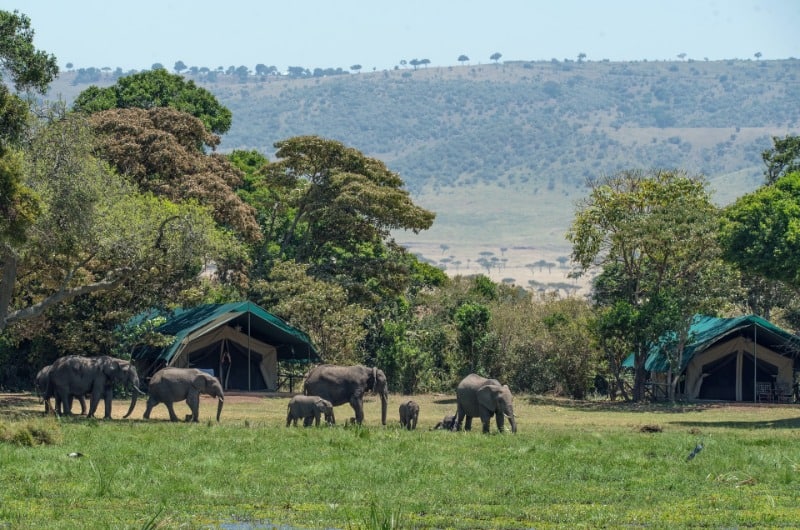
Single-use plastic bags are illegal in Kenya | Photo credit: David Clode
Responsible tourism is about finding a balance between communities, conservation and travellers, and Kenya is an expert at pulling this off.
A top responsible travel destination in Africa, Kenya is home to 55 national parks which allow the country’s formidable wildlife to roam free and protected.
Visitors can spot the ‘Big Five’ there (buffalo, elephant, rhino, lion and leopard).
Kenya also has one of the world’s toughest bans on single-use plastic bags with heavy fines and even a four-year prison sentence for using them!
10. Fiji
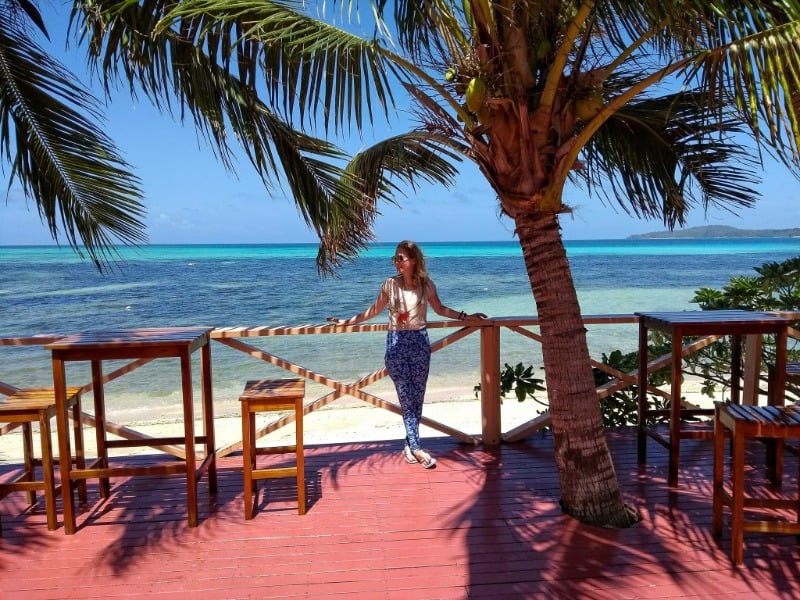
The Yasawas is an archipelago of volcanic islands in the Western Division of Fiji. Responsible tourism has been in place here for over 30 years, ever since the first resorts were built.
The locals weren’t keen on having large corporate-run resorts so they decided to keep things small. Most resorts are owned by local villagers and they have a fairly low carbon footprint. It’s common to only have electricity at night and water heated by the sun.
Pristine beaches and coral reefs teeming with life make the Yasawas a haven for nature lovers. Fiji is also a fantastic solo travel destination (check out my island-hopping itinerary!).
11. Borneo

Borneo is an ecotourism paradise for nature enthusiasts. The world’s third-largest island is shared by Malaysia, Indonesia and Brunei and it’s one of the most biodiverse regions on the planet.
It’s home to ancient rainforests that have been around since the dinosaurs and you can spot countless species of flora and fauna, including orangutans.
Much of these rainforests have come under threat from palm oil plantations, but the Danum Valley in Sabah on the Malaysian side is a protected conservation area.
12. The Galápagos Islands, Ecuador

It doesn’t get much better than the Galápagos Islands for spotting weird and wonderful wildlife.
This UNESCO World Heritage Site has been called ‘a living laboratory of evolution’ and some of the species of flora and fauna have not been found anywhere else in the world – including the giant tortoise!
Visitors are required to have a guide with them at all times to protect this special place. Highlights include visiting the Charles Darwin Research Centre, diving and hiking.
13. Hawaii

Hawaii has the highest number of endangered and threatened plant and animal species on the planet and responsible initiatives play a huge role in protecting them.
Care for the environment referred to as ‘malama aina’, is an important and traditional part of Hawaiian values. There is a wealth of nature-based and sustainable activities across Hawaii’s eight major islands.
Hawaii has dealt with issues of overtourism and devastating wildfires on Maui.
I recommend choosing small, boutique hotels and homestays over large-scale resorts to make sure your money is going directly into the local communities and places that need it most.
14. Panama
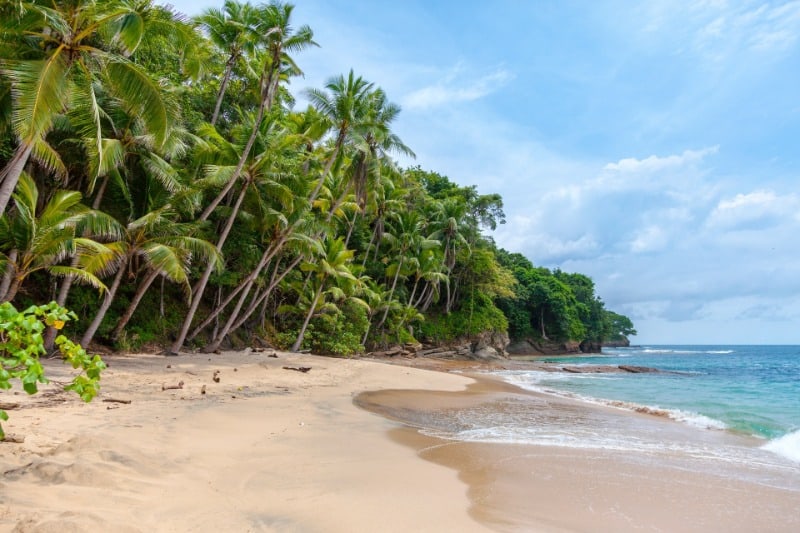
Panama is a relatively new responsible tourism destination, but its burgeoning tourism industry coupled with its stunning natural environment has caused it to get serious about its green initiatives.
The country has 49 national parks so activities here are heavily nature-focused.
Observe nesting turtles at Bocas del Toro, spot humpback whales at Isla Iguana and visit the Coiba National Park, a UNESCO World Heritage Site and subject of international studies for biodiversity.
15. Morocco

Morocco is ranked as one of the most sustainable destinations in the world as measured by the Climate Change Performance Index.
Plastic bags were banned in 2016 and the country aims to have 52% of its energy come from renewable sources by 2030.
Top eco-friendly highlights of your trip include visiting the local social enterprise shops, buying upcycled souvenirs and heading out on hikes in the Atlas Mountains.
16. Jordan

Jordan is a growing ecotourism destination thanks to the Royal Society for the Conservation of Nature which oversees 10 protected reserves across the country.
Tourism is cleverly used as a way to carry out conservation efforts. Business owners and hoteliers promote tourism throughout the country whilst conserving Jordan’s natural landscape.
This scheme has been instrumental in providing jobs and economic stability in some of Jordan’s poorest communities.
One such example is the gorgeous Feynan Ecolodge on the edge of the mountainous Dana Biosphere Reserve.
17. Guyana

A few years ago, this small South American country was awarded ‘Best in Sustainable Tourism’ by the Latin American Travel Association.
Groups like the Guyana Tourism Authority have been largely responsible for this success due to their commitment to promoting community life and conservation.
Here, tourism provides jobs whilst preserving local traditions and promoting low-carbon lifestyles.
Guyana is also a top destination for biodiversity. Activities include visiting the stunning Orinduik Falls, walking along the rainforest canopy in Iwokrama and hiking in the Kanuku Mountains.
18. Chumbe Island, Tanzania

Chumbe Island, located just off the coast of Zanzibar, is home to the world’s first marine protected area.
It was set up in 1991 when the formerly uninhabited island was discovered to be one of the last coral islands in the region. As a result, this protected area has some of the most exceptional and diverse coral reefs in the world.
Visitors can stay at the award-winning ecolodge, enjoy candlelit dinners on the beach, explore the reserve and snorkel along the coral reef.
19. Portugal

ITB Berlin, one of the world’s leading travel trade shows, crowned Portugal as the ‘Best European Destination for Sustainable Tourism’ in 2019.
Much of the coastline had previously suffered from overdevelopment, but now, effort has been made to introduce protected areas across the country to preserve its natural environment.
Its major national park is Peneda-Gerês close to the Spanish border. You can also head to the mountainous Montesinho, near Bragança and Alentejo, near Cabo de São Vicente on the coast.
20. Gozo, Malta
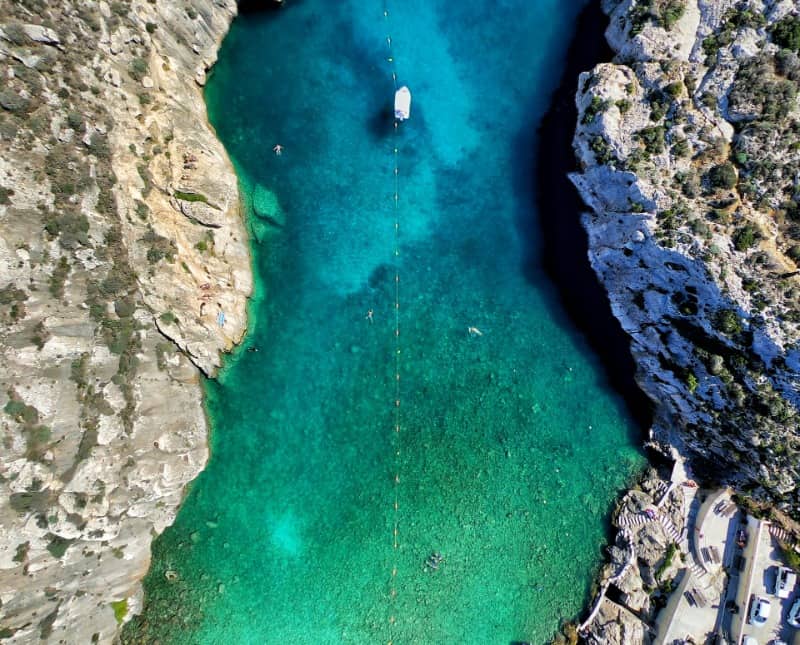
Tucked between Sicily and the North African coast, Malta is a stunning Mediterranean archipelago and one of the top responsible travel destinations in Europe.
Many hotels across Malta (like this gorgeous one) have been awarded the Eco Certification for their commitment to socioeconomic, environmental and cultural sustainability.
The island of Gozo has won awards for its dedication to protecting local culture and tradition.
Visitors can enjoy the beaches at Ramla Bay and San Blas Bay and and explore the UNESCO Neolithic Ġgantija Temple ruins.
21. Nepal

Nepal is a bucket list destination for adventure travellers. The draw of the Himalayas is irresistible for those eager to climb the highest mountains in the world. Overtourism was starting to become a serious problem.
The trail up Mount Everest alone was heavily polluted. Now steps have been taken to mitigate mass tourism and create a more sustainable future for Nepal.
The Pacific Asian Tourist Association is working with the country to divert areas to less-visited areas whilst ensuring that the proper infrastructure to handle it is in place.
Specific community-based tours you can join include Seven Women and Social Tours.
22. Spain

Spain has been one of Europe’s most popular ecotourism destinations since the 1990s.
The country is home to one of Europe’s largest national parks, Los Picos de Europa, which includes the dramatic, rugged mountain peaks of the same name.
Visitors to Spain can join eco-tours or go camping as part of their sustainable travel experience.
If you would prefer a city break, Madrid has the greenest space of any European city and Barcelona also has a strong focus on renewable energy and sustainable transport.
23. The Netherlands

The Dutch take sustainability seriously which is understandable when almost a third of the country is below sea level.
As much as 60% of all household waste is sorted and recycled, and visitors are expected to take the same care when throwing rubbish away.
Bicycles are a hugely popular way of getting around and there are plenty of places where you can rent them.
If you’re a foodie then you’ll be pleased to discover that the country has a fantastic range of eco-conscious and community-oriented food options.
24. Rwanda

Seeing the mountain gorillas in Rwanda is a top bucket list wildlife activity, but if your trip falls on the last Saturday of the month then you might want to pack a litter picker.
Known as ‘Umuganda,’ this event is a community day of national housekeeping which requires everyone to go out into their neighbourhood and pick up rubbish. The result? This African country is one of the cleanest nations on Earth!
Rwanda is also big on conservation, allowing endangered animals such as rhinos, elephants and lions to thrive.
Editor’s tip: G Adventures does an ethical mountain gorilla experience.
25. Sweden
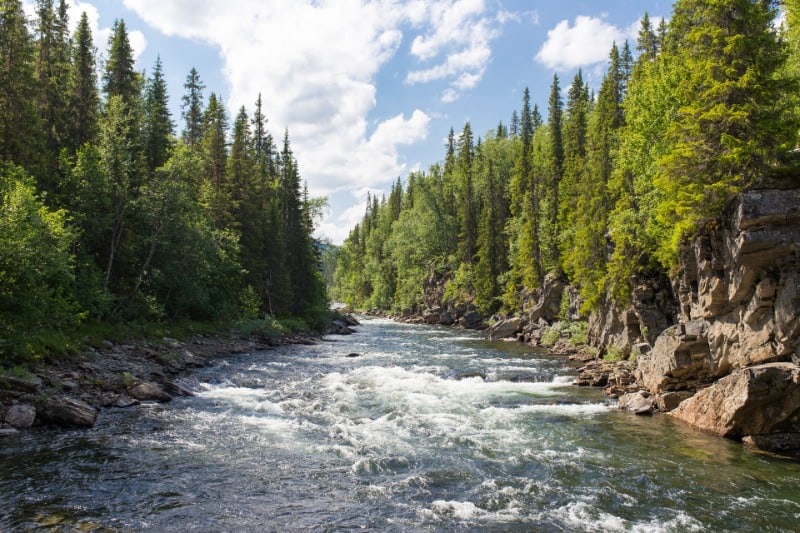
Sweden is home to the climate activist Greta Thunberg so it’s unsurprising that the country is a world leader in sustainability.
Renewable energy is popular here. 54% of its energy comes from renewable sources and the country plans to reach 100% by 2040.
Sweden was the first country in the world to impose a carbon tax on carbon-intensive fuels like natural gas and oil.
A great perk when visiting Sweden is that 63% of the country is forested and citizens are allowed by law to roam across the land whether it’s publicly or privately owned.
26. Slovenia

Slovenia’s natural beauty has made it a hotspot for outdoor lovers. In 2017, it was named by National Geographic as the most sustainable country on Earth and its capital, Ljubljana is a model of responsible urban development.
Its inner city is traffic-free and it’s the largest car-free zone in the European Union. To get the full eco-friendly experience, you can go hiking, camping and kayaking.
If you’re planning a trip for the end of May, make sure you check out the annual Bohinj Wild Flower Festival which usually lasts until the beginning of June.
27. Uruguay
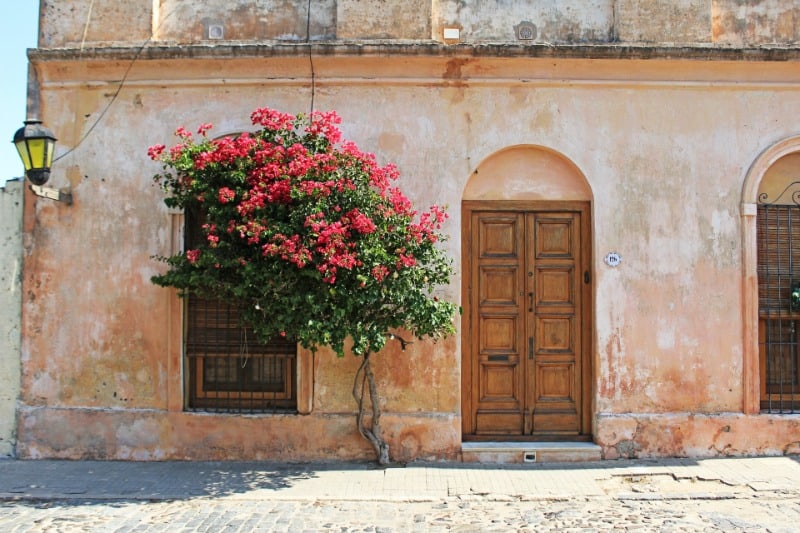
Since 2016, wind, water and agricultural waste have generated up to 97% of Uruguay’s electricity, nearly 100% renewable!
Uruguay may be the second smallest country in South America, but it ranks first in peace, democracy, lack of corruption, prosperity, security and almost total absence of extreme poverty.
Make sure you add the curious coastal hamlet of Cabo Polonio to your itinerary. It has no roads, no electricity and the locals often eat communal dinners by candlelight.
28. Lake Tahoe, USA

Lake Tahoe Visitors Authority have recently launched a sustainable tourism initiative with Kind Traveler, a socially conscious hotel booking platform to help preserve Lake Tahoe and its surroundings.
Donations from this initiative go to Take Care Tahoe, a group of more than 30 local organisations that are working to make it easier for visitors to learn about the area.
Events you can get involved with here include beach cleanups, wildflower hikes and eco-friendly festivals.
29. Scotland

Scotland is known for its dramatic unspoilt landscapes so it’s unsurprising that it’s one of the top responsible tourism destinations in the world.
It was one of the first countries to sign up to adopt the Global Goals in 2015.
This vision, which has now been signed by more than 190 countries aims to end poverty, inequality, and hunger and protect the environment.
Scotland is also an ideal hiking destination (although I wouldn’t recommend hiking alone unless you’re experienced).
Read More: Scottish Highlands Itinerary: The Perfect 10 Day Itinerary
30. Singapore

Singapore is a very small nation but that doesn’t stop it from taking sustainability seriously.
Its highly sophisticated water system involves recycling wastewater into top-quality drinking water.
More impressive still is the nation’s Green Mark certification which encourages the use of solar panels, cooling units and rainwater harvesting to reduce carbon emissions.
You’ll also notice that trees, shrubs and flowering plants have been incorporated into its urban design at every turn.
31. Switzerland
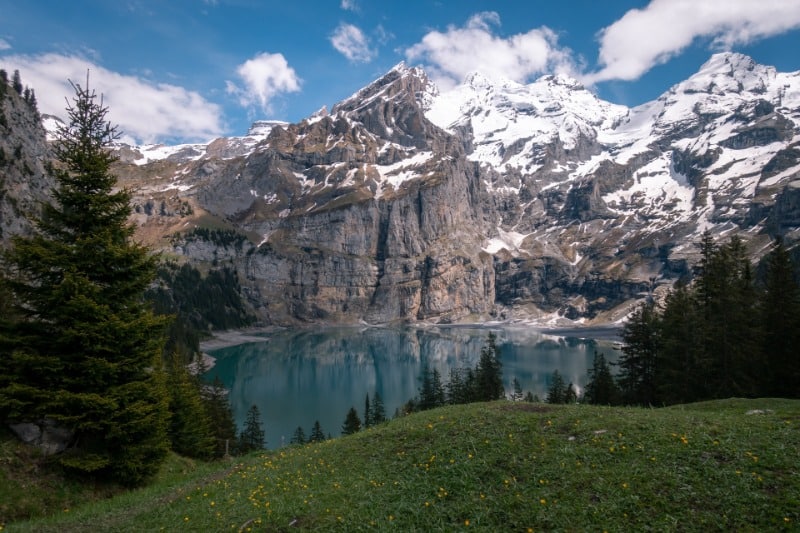
When it comes to the environment, the Swiss don’t like to mess about. The country is home to the oldest and wildest national park in Europe and volunteer ‘mountain cleaners’ patrol the countryside picking up rubbish that’s been left behind.
Speaking of rubbish, one of its policies is the ‘polluter pays scheme’ where residents must buy special bin bags to put their waste in. For a truly eco-friendly experience, try a stay on an authentic Swiss farm.
Prices are cheaper than hotels and you get a real chance to immerse yourself in nature. One way you can do this is through WWOOF.
Final thoughts on the world’s most beautiful responsible tourism destinations
The world is full of bucket-list-worthy natural sights, but each one is as fragile as it is beautiful.
As a travel lover, I’m often torn between wanting to see as many of them as possible and wondering about the damage I could unwittingly be inflicting.
Thankfully, an increasing number of destinations are using tourism to preserve their environments and support local communities. It’s never been easier to support sustainable travel initiatives and use your money as a force for good.
These responsible tourism destinations are just the start!
Looking for more sustainable travel inspiration? Check out these articles!
- Top Sustainable Travel Tips That Will Help the Planet
- What is Ecotourism and Why is it Important?
- 9 Amazing Ecotourism Activities To Do Around The World
- An Easy Slow Travel Guide to Mastering the Art of Experiencing More
Inspired? Pin for later!
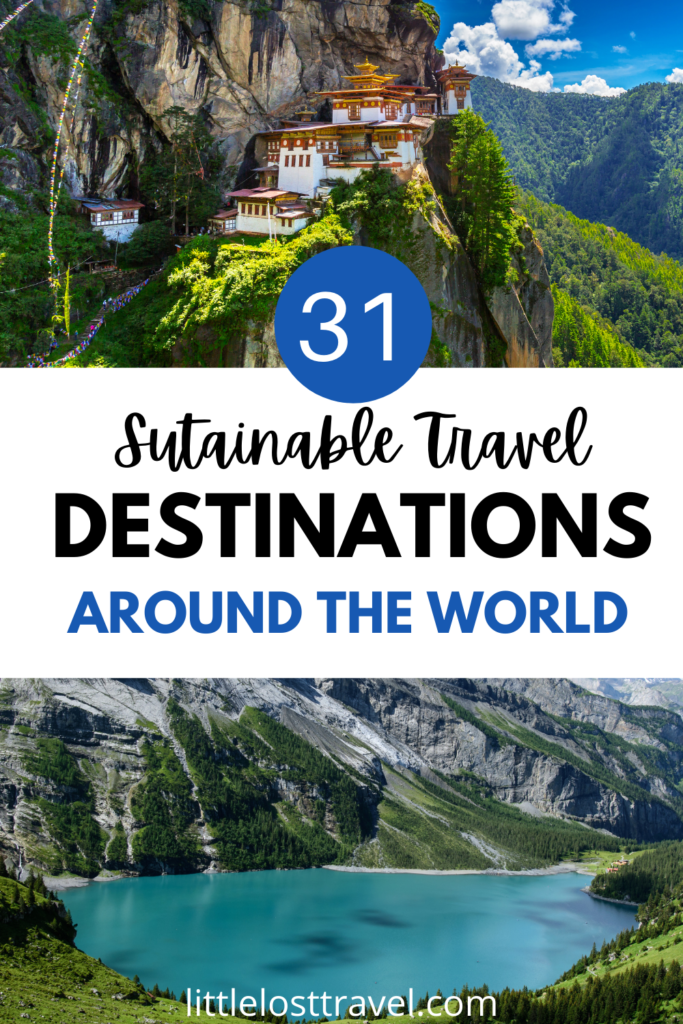
This post may contain affiliate / compensated links. As an Amazon Associate, I also earn from qualifying purchases. For full information, please see my disclaimer here.




What an exhaustive list! Very interesting to read about what each of these countries/destinations is doing. One reason that I’ve always personally loved Costa Rica so much is all the wise ecotourism measures they have taken over the years.
Thank you! Yes Costa Rica is a world leader in sustainable tourism!
what a great list! I will use this list in the future as I consider destinations. Sustainable tourism is 100000% the way forward! pinned it for later!! xx
Thank you! Yes, they’re all very worthy of the bucket list!
Wow, have you made it to all the places on this list? I think we’ve only made it to New Zealand and Norway, but this is a great round up – and pleasing to see parts of the earth that aren’t trashed by mankind.
Haha I wish! I’ve been to a few of these destinations but otherwise, it’s definitely a bucket list1
Great round up. I would not have thought that Spain and Portugal would be on there. I hope in Ireland we can start to catch up now we have to he Green Party in government. A lot of work to do though.
Thank you! I was pleasantly surprised too. I think England has some work to do too.
Hi, interesting read and I see this as a growing concern for people. Do you have specific hotels (like Svart) we can make a collection with at PorterTravel?
Thanks!
Hi Miles,
Thank you!
There are some great ones here: https://littlelosttravel.com/the-10-best-ecolodges-in-the-world/.